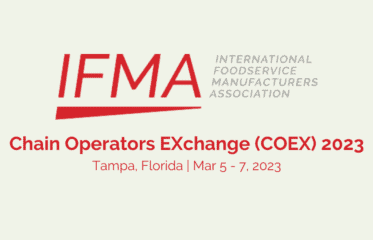Beyond GHG: Study Finds Animal-Free Dairy Sustainable in Multiple Metrics
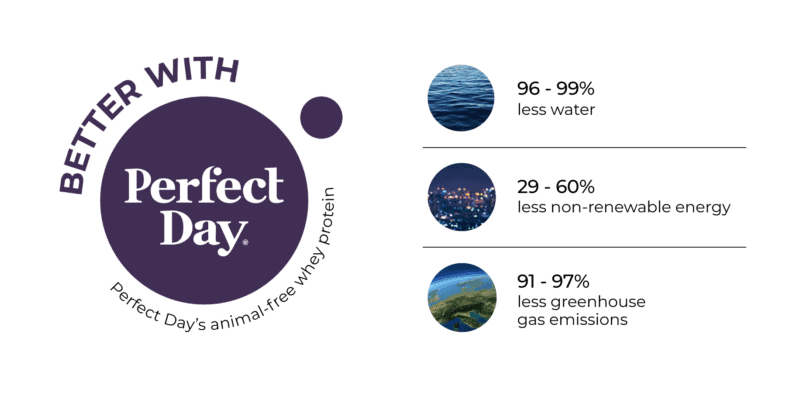
In August, the United Nations Intergovernmental Panel on Climate Change (IPCC) issued a new report that warned of “widespread, rapid, and intensifying” global warming caused by human activities.1 The report issues a clarion call for large-scale, sustained reductions in greenhouse gas (GHG) emissions to curb the increasing frequency of intense storms, droughts, fires, heatwaves, shrinking snow cover, rising sea levels, and threats to crop yields.2 The report also stresses that we’re unavoidably locked into some climate change at this point. Exactly how bad it will depend on how urgently we take action to change our largest-emitting systems. Importantly, there’s still time to fend off the worst effects — but time is limited.
How Livestock is Harming the Planet
Animal agriculture both perpetuates and suffers from planetary warming. Livestock contributes 14.5% of all GHG emissions globally, more than half of which are attributed to beef and dairy cattle.3 The average dairy farm uses between 800 and 1,200 kilowatt-hours per cow every year.4 Each milk cow consumes between 30 and 50 gallons of water daily, and up to double that amount during periods of heat stress, further exacerbating water scarcity in times of drought.5 When you consider the sheer number of milk cows in California alone — over 1.7 million6 — the implications for water and energy are enormous. We know that dairy industry leaders are looking for ways to improve these numbers. Perfect Day’s technology is one tool available for producing protein with lower environmental impacts across multiple metrics.
Impact of Animal Free Whey Protein Vs. Cows
In April, we published a life cycle assessment (LCA) on the greenhouse gas impact of animal-free whey protein compared to that of cows. The ISO-compliant study showed that animal-free whey generates up to 97% less greenhouse gas compared to conventional production. We’re pleased to share that, as part of our ongoing commitment to minimizing our environmental impacts, we’ve since completed a new ISO-compliant study that compares our animal-free whey production’s use of blue water and nonrenewable energy to that of bovine milk production.
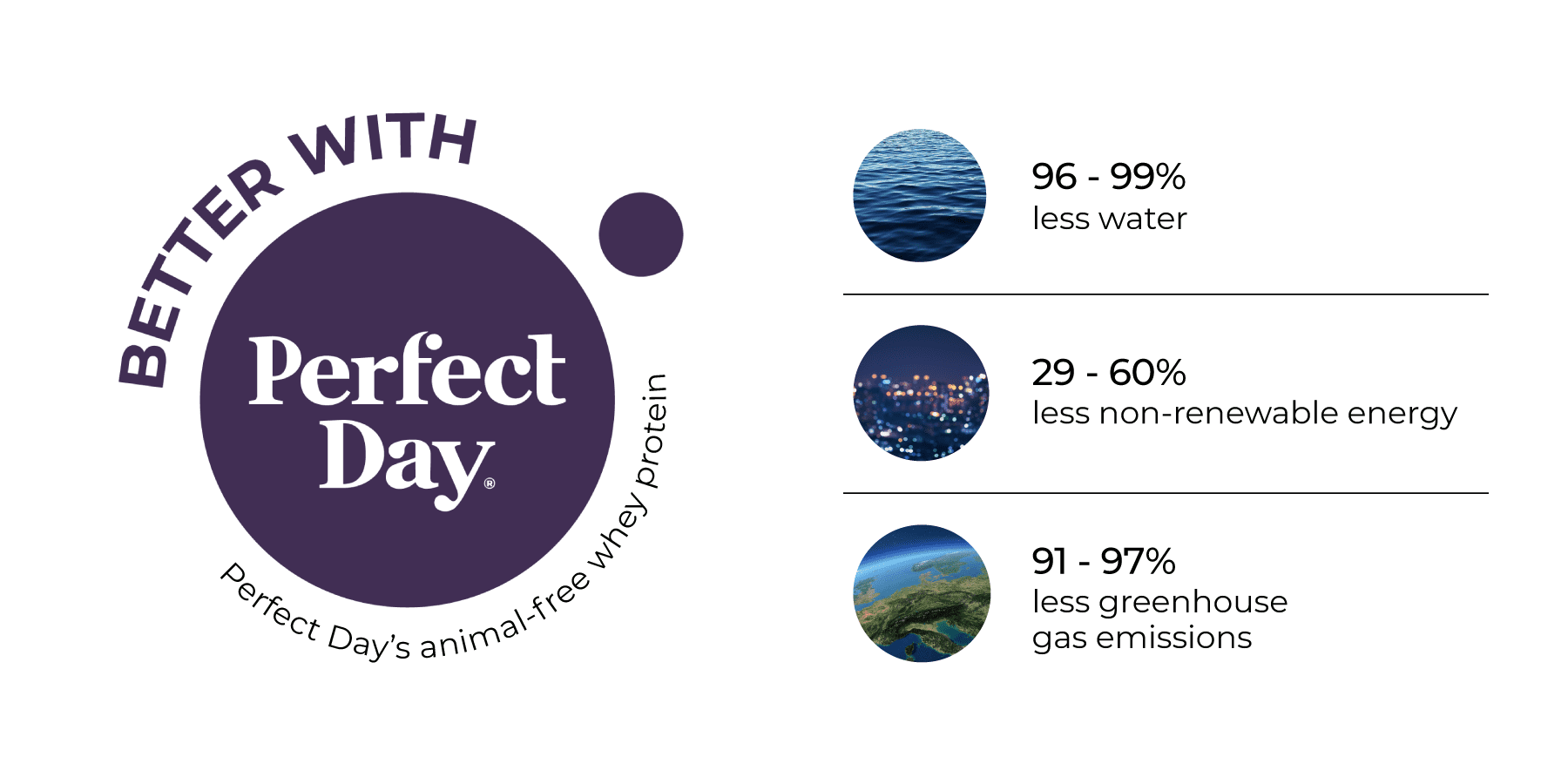
This latest report finds that, in addition to generating up to 97% lower greenhouse gas emissions, Perfect Day’s animal-free whey protein demands up to 99% less water and uses up to 60% less nonrenewable energy than the water and energy used to make protein from cow’s milk. Or read the Executive Summary.
Let’s Talk Numbers
This report looked at the greenhouse gases, blue water consumption, and nonrenewable energy use associated with our animal-free whey protein production from cradle to gate (the point of resource extraction to the point at which whey powder is delivered to partners). WSP USA, Inc., an independent leader in life cycle assessments, compared our animal-free whey to seven LCAs previously published on proteins from cow’s milk. We provided primary data, while WSP sourced comparative data from ISO-compliant databases.
WSP found that our animal-free whey protein demands 96.2–98.7% less blue water than the amount of water needed to make an equivalent amount of protein from cow’s milk. Blue water is defined as surface and groundwater consumed or polluted by the production of a good or service. In Perfect Day’s case, the top drivers of blue water consumption are protein development (68%, mostly from feedstock production) and equipment cleaning (19%).
WSP also found that our animal-free whey demands 29.9–59.7% lower energy from nonrenewable sources than the energy required to make an equivalent amount of protein from cow’s milk. Nonrenewable energy is derived from finite sources like coal, oil, and natural gas. The topmost driver of Perfect Day’s nonrenewable energy use comes from utilities (53%). We used the average U.S. energy grid composition (which is dominated by coal and natural gas) as proxy for the specific energy mix used in Perfect Day’s protein production process.
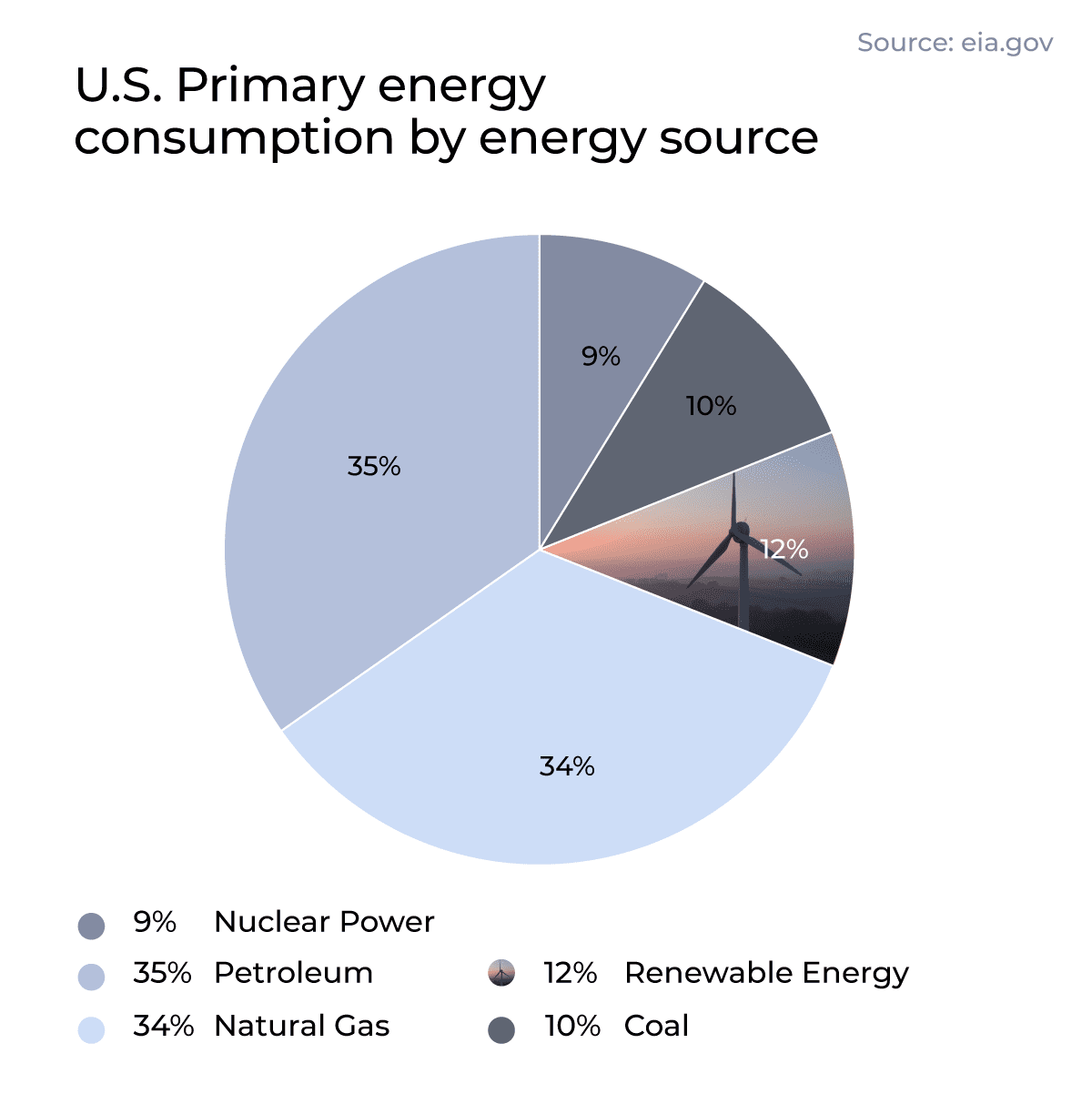
The Numbers in Context
The numbers alone mean nothing if we don’t understand the scale of their impacts, so let’s put these metrics in context! If all U.S. food makers replaced animal-derived whey with Perfect Day’s animal-free whey, we could save 18,600 billion gallons of water and 75 billion megajoules of nonrenewable energy per year.
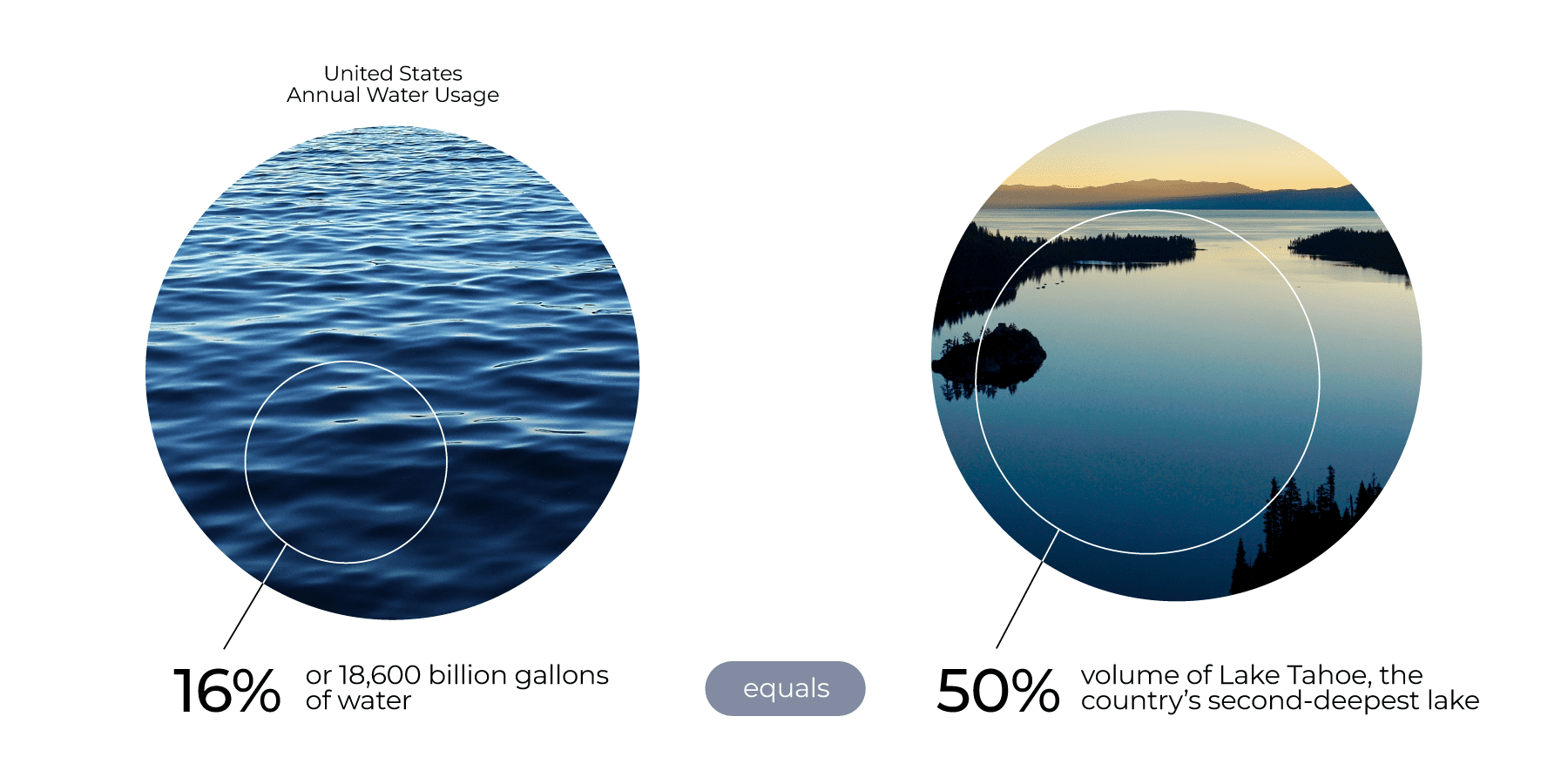
In more relatable terms: 18,600 billion gallons of water is approximately 16% of the United States’ annual water usage,7 and roughly half the volume of Lake Tahoe, the country’s second-deepest lake.8 Similarly, 75 billion megajoules (~20.8 million megawatt-hours) is enough energy to power the entire state of Idaho for one year.9
But what if we partnered with existing leaders in the dairy industry to use animal-free protein in just 5% of the products currently on the market? We still get impressive water and energy savings.
A 5% transition to animal-free milk proteins would mean:
- Saving 930 billion gallons of water, enough to fill 1,408,174 Olympic-sized swimming pools!10
- Saving 3.75 billion megajoules (~1.04 million megawatt-hours) of energy, enough to power the entire city of Washington, D.C. for 6 years, or all 20,000 of the Eiffel Tower’s lightbulbs for 130 years!11
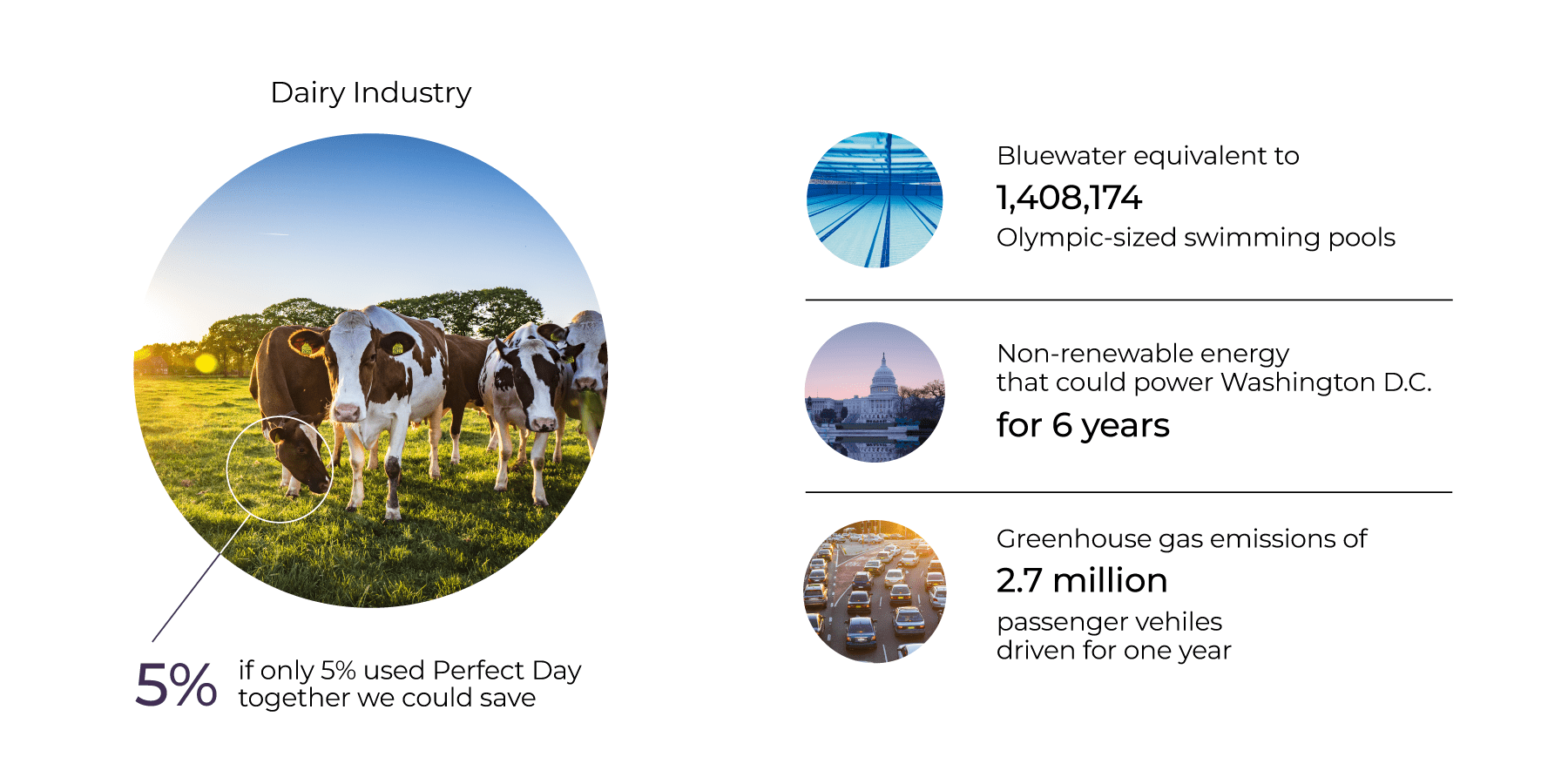
These incredible water and energy savings demonstrate how significant the returns are with even meager shifts in supply chains — and the power we can have when we engage in collaborative partnerships to move the needle on climate change.
Why These Metrics? Mitigation and Adaptation
We have two levers for responding to climate change: mitigation and adaptation.12
Mitigation is the proactive reduction and stabilization of the greenhouse gases building in our atmosphere; basically, stopping the production of heat-trapping gases at their source. Reducing the use of nonrenewable energy sources is a mitigative strategy for tackling climate change.
Adaptation refers to adaptive responses, or systemic adjustments to the global warming effects that will occur regardless of any mitigative actions we take against climate change. Minimizing total water use is an example of an adaptive response to the climate disruptions we now know are inevitable. The United Nations says that as its availability becomes less predictable, water — or lack thereof — will become the primary medium through which we’ll experience climate change.13

Indeed, we’re already experiencing water disruptions across the globe, in the form of dangerously severe droughts and depleted water supplies. A record-breaking heat dome enveloped as much as a quarter of the continental U.S. this summer, parching reservoirs, damaging crops,14 threatening livestock,15 and precipitating the conditions for the devastating wildfires that are increasingly commonplace year over year.16
Water-saving strategies for food production will be an important part of how we adapt to a water-scarce world. Because animal-free dairy production uses up to 99% less water than dairy from cows, switching to climate-friendly ingredients can be a strong adaptive strategy for preserving the nourishing foods we love in a world with limited, unpredictable, and vulnerable water supplies.
There’s Hope — If We Act Now
The IPCC is unequivocal that humans are responsible for global warming. But if human activity is the cause of climate change, that means it’s also within humanity’s reach to change the practices that cause the greatest impacts. In an appeal to hope, Claudia Tebaldi, a lead IPCC author and scientist at the Pacific Northwest National Laboratory, reminds us that we can still curb the worst effects of climate change, “if we are able to limit our footprint now. Every little bit counts.”17
The global food system is an outsized part of that “every little bit.” Changing not our foods, but the processes we use to make them, can be part of a suite of solutions across sectors that yield immediate positive gains.
We don’t have time to waste.
- Intergovernmental Panel on Climate Change. (2021, August 9). Climate change widespread, rapid, and intensifying. ipcc.ch/2021/08/09/ar6-wg1-20210809-pr/
- Philpott, Tom. (2021, August 11). The UN’s big climate report buried some bad news about our eating habits. Mother Jones. motherjones.com/food/2021/08/ipcc-report-methane-cows-oil-and-gas-emissions/
- Food and Agriculture Organization of the United Nations. (n.d.). Key facts and findings. fao.org/news/story/en/item/197623/icode/
- Orlando Utilities Commission. (2021, March 22). Dairy farms. Business Energy Advisor. ouc.bizenergyadvisor.com/article/dairy-farms
- Thomas, Craig. (2011, April 5). Drinking water for dairy cattle: Part 1. Michigan State University Extension. canr.msu.edu/news/drinking_water_for_dairy_cattle_part_1
- Shabandeh, M. (2021, May 17). Leading 10 U.S. states based on number of milk cows in 2018 to 2020 (in 1,000s). statista.com/statistics/194962/top-10-us-states-by-number-of-milk-cows/
- United States Geological Survey. (n.d.). Total water use in the United States. usgs.gov/special-topic/water-science-school/science/total-water-use-united-states
- United States Department of Agriculture. (n.d.). Lake Tahoe Basin mgt unit: About the area. Forest Service. fs.usda.gov/main/ltbmu/about-forest/about-area
- U.S. Energy Information Administration. (2020, November 2). State electricity profiles. eia.gov/electricity/state/
- Patagonia Area Resource Alliance. (n.d.). How much water does an Olympic sized swimming pool hold? patagoniaalliance.org/wp-content/uploads/2014/08/How-much-water-does-an-Olympic-sized-swimming-pool-hold.pdf
- Benson Smith, Sam. (2017, August 9). You’ll never believe exactly how much it costs to light the Eiffel Tower every day. Reader’s Digest. rd.com/article/the-cost-to-light-up-eiffel-tower/
- NASA. (n.d.). Responding to climate change. climate.nasa.gov/solutions/adaptation-mitigation/
- United Nations. (n.d.). Water and climate change. UN Water. unwater.org/water-facts/climate-change/
- Werner, Erica and Reiley, Laura. (2021, August 27). California’s ‘Cantaloupe Center’ struggles to reign supreme as drought pummels agriculture across the West. The Washington Post. washingtonpost.com/us-policy/2021/08/27/california-drought-farmers-cantaloupe/
- Osgood, Brian. (2021, August 20). U.S. dairy farms grapple with high feed prices, drought. Al Jazeera. aljazeera.com/economy/2021/8/20/us-dairy-farms-grapple-with-high-feed-prices-drought
- Niiler, Eric. (2021, July 28). Extreme heat could also mean power and water shortages. Wired. wired.com/story/extreme-heat-could-also-mean-power-and-water-shortages/
- Dennis, Brady and Kaplan, Sarah. (2021, August 10). Humans have pushed the climate into ‘unprecedented’ territory, landmark U.N. report finds. The Washington Post. washingtonpost.com/climate-environment/2021/08/09/ipcc-climate-report-global-warming-greenhouse-gas-effect/
We’d love to hear your thoughts!
Your email address will not be shared.
